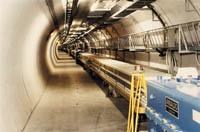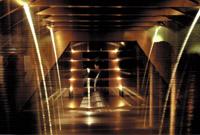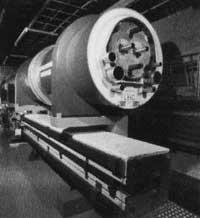CERN fifty years
2004/05/01 Roa Zubia, Guillermo - Elhuyar Zientzia Iturria: Elhuyar aldizkaria
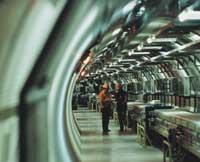
After World War II, scientific research in Europe was not in very good condition. On the one hand, the consequences of the war itself were visible, both in science and in any other area of life. European researchers had few resources, little money. Of course, the priority for investing money was not science. It could not be. On the other hand, many scientists had fled, mostly to the United States, so it was not easy to organize good and efficient research groups.
It must be understood that at that time the environment was not the most suitable for investigating physics. Nuclear physics was the most developed line of research during the war. And once the war was over, it was no wonder that nuclear physics and the development of weapons were largely synonymous for people. But physics research was not only related to bombs and rockets.
They were discovering new particles smaller than the atom and had nothing to do with weapons. On the other hand, nuclear fission could have great importance in energy production. In addition, in 1947 the transistor was invented in the United States and new materials were being investigated to improve the transistor. We must not forget that most of the current technology is based on transistor and therefore particle research.
In this situation, European scientists had to do something to promote research. French Louis de Broglie, Nobel Prize in Physics of 1929, made his first proposal in this regard. At that time they created many organizations based on international cooperation, why not in the field of science? At a congress held in Lausanne in 1949 he proposed the construction of an international European laboratory.
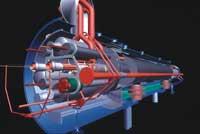
Several Nobel Prizes collaborated in the development of the idea in congresses organized by UNESCO. Finally, on September 29, 1954, the CERN laboratory was inaugurated with the sponsorship of twelve European peoples.
First CERN accelerators
From this time on, particle research is necessarily based on accelerators. Accelerators or synchrotrons (for these machines both names are used) accelerate the particles and make them collide with great energy. The distribution of the components of the nucleus of an atom requires a large amount of energy, so the detection of these components or particles is also essential.
In short, the main objective of this research is to answer a simple question: what is matter made of? And when you say matter, you mean everything. For all things are made of atoms, and atoms are made of protons, neutrons, and electrons, what are they made of? To investigate it, you have to collide protons, neutrons and electrons to see which particles come out when they "break down". Today we have the answer that these particles are manufactured in quarkez, but there are many other unanswered questions.
At CERN, therefore, it was essential to start making accelerators. The first was carried out before the late 1950s, with which an energy of 600 million electronics (600 MeV) could be obtained. Keep in mind that the electron-volt (eV) is an energy unit that needs an electron to reach a potential of a volt from the stop. Think that the energy of a small domestic battery yields the potential of 1.5 volts to millions of electrons. Therefore, it is no wonder that an accelerator provides 600 MeV.
Over the years, CERN began to use increasingly better technology, making better and better accelerators. The synchrotron could reach the energy of 300 GeV (300,000 million eV) built for 1971, which means 500 times more energy than the first. This synchrotron was a circular tunnel seven kilometers long. A beautiful installation.
Research with these accelerators brought results practically from the beginning. In 1973, it was discovered that the size of protons increases as energy increases, indicating that protons are made up of smaller particles that can be distributed through energy donation.
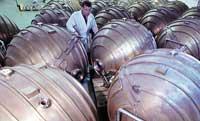
There have been many synchrotrons launched by CERN. In recent years the most famous has been the LEP (Large Electron-Positron collider), a 27-kilometer cycle that began in 1981 and paralyzed in 2000. He has given many results, highlighting the Nobel Prize in Physics awarded by scientists Carlo Rubbia and Simon van der Meer in 1984 for his work on this accelerator.
The work done by the Dutch Van der Meer had to do with the improvement of particle batches. According to this work, in addition to making accelerators bigger and bigger, you can improve the games that accelerate. In fact, in 1978 this physicist invented a technique to accumulate those ray beams. The "cooled" beam increased its intensity and managed to accumulate them. This technique significantly increased the effectiveness of PAs and other synchrotrons.
But the time of the PPPs ended four years ago. Instead a new accelerator is being manufactured: LHC (Large Hadron Collider). This new machine will reach an energy of 1 TeV, that is, a billion electron.
Particle detection cameras
In addition to the accelerators, many other devices were manufactured. For example, hydrogen particle research chambers or other media were developed, endowed with the largest magnets until then. These cameras were at that time the most advanced particle detection devices in the world, which can ultimately be detected by colliding particles with the atoms of the camera.
In 1967 a camera called Gargamelle was formed. This chamber was filled with heavy liquid and the neutrino was used to "hunt". The most significant discovery made with this camera was related to these particles: that neutrinos can interact with other particles while remaining neutral.
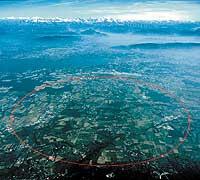
The line of camera and detector research has also brought great benefits to CERN. In fact, Frenchman Georges Charpa received the Nobel Prize in Physics in 1992 for his invention of the proportional multithreaded camera, a type of detector.
Future
In 2001, researchers from the CERN announced new results in the research of the matter-material pair. Why is matter in nature more common than antimatery? To answer these kinds of questions, numerous research on particles are needed, with increasing energy. New resources are being prepared at CERN.
CERN celebrates its celebration this year. But that doesn't mean they stopped working. As we have said, one of the priorities is the construction of the LHC. In any case, basic physics research will remain the place of CERN, at least for the next fifty years.
CERN membersAt the inauguration, twelve states participated in the CERN: West Germany, Belgium, Denmark, France, Greece, Italy, Holland, United Kingdom, Sweden, Switzerland and Yugoslavia. Since then there have been many moves on this list. Austria and Spain were joined in 1959 and 1961 respectively. In 1961 Yugoslavia ceased to belong to the association. Spain left the group in 1969, but in 1983 it rejoined. Portugal entered 1985 and the latest additions so far have been: Finland and Poland in 1991, Hungary in 1992, Czech Republic and Slovakia in 1993 and Bulgaria in 1999. Therefore, there are currently twenty CERN member states. In addition, the laboratory has several external observers, six states and two institutions: India, Israel, Japan, Russian Federation, United States, Turkey, the European Commission and UNESCO itself that participated in the creation of CERN. |

Gai honi buruzko eduki gehiago
Elhuyarrek garatutako teknologia



